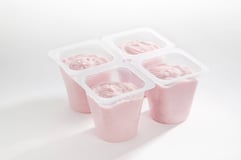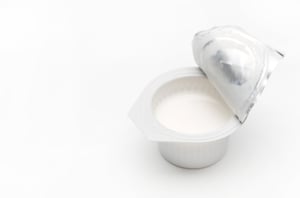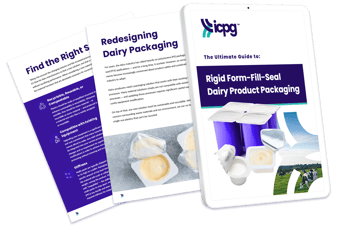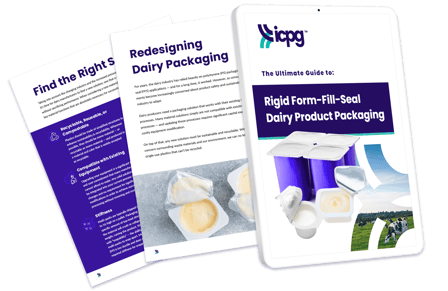 Yogurt, cream cheese, cottage cheese, sour cream, butter. What do these items all have in common? Yes, they’re all classified as dairy products. But what else do they have in common? They’re all perishable foods, and require specialized dairy packaging for preservation, which is crucial for maintaining product shelf-life and ensuring safety and quality of the product. Continue reading to learn more about the key considerations and aspects of dairy packaging and how ICPG can help.
Yogurt, cream cheese, cottage cheese, sour cream, butter. What do these items all have in common? Yes, they’re all classified as dairy products. But what else do they have in common? They’re all perishable foods, and require specialized dairy packaging for preservation, which is crucial for maintaining product shelf-life and ensuring safety and quality of the product. Continue reading to learn more about the key considerations and aspects of dairy packaging and how ICPG can help.
What are the Barrier Requirements for Dairy Packaging?
In dairy packaging, identifying and determining the shelf-life and organoleptic requirements of the product for dairy applications are essential components of the package development process. This includes considering factors like food processing, UV degradation, supply chain, consumer appeal and intended use. With dairy encompassing such a wide variety of products, barrier vs non-barrier requirements for applications in this market are typically dictated by the food product, storage method and target shelf-life.
Understanding the required OTR (Oxygen Transmission Rate) and MVTR (Moisture Vapor Transmission Rate) is crucial for achieving target shelf life in dairy packaging. The next step is developing a material structure with the appropriate barrier characteristics to protect the product throughout its desired shelf-life performance. For dairy products requiring a high-barrier material structure, such as creamers, development of performance structures can be achieved through a multi-layer coextrusion process leveraging materials such as EVOH to achieve the required OTR requirements. On the other hand, refrigerated dairy products, with a shorter shelf-life, such as yogurt, typically have lower barrier requirements and often do not require the incorporation of EVOH.
Optimizing the material structure through the use of innovative materials, such as ICPG's XPP Enhanced Barrier Polypropylene, can present opportunities to extend the shelf-life of both shelf-stable and refrigerated dairy products, by providing up to 90%/90% improvement in OTR/MVTR properties vs PP and 100%/150% OTR/MVTR vs PS - without the incorporation of specialty barrier materials or coatings - for a simplified and recyclable barrier material structure. This approach is significant in dairy packaging, providing improved OTR/MVTR properties compared to traditional materials.
What is the Processing Method for Dairy Packaging?

The choice of processing methods for dairy packaging directly correlates with material choice and target package performance. Common processing techniques for packaged dairy products include cold-fill, liquid-fill, fill-seal, form fill seal, UHT, pasteurization & aseptic processing. The packaging and processing method, along with the barrier requirements will play a significant part in determining the best material structure to ensure product safety and integrity.
What is the Best Material Choice for Dairy Packaging?

Today’s dairy packaging solutions offer a variety of material choices. Additionally, the type of packaging and processing method as well as the product’s target shelf-life can affect material structure design.
If the product will be packaged in the form fill seal process, either HIPS or ICPG's XPP could be used. For thermoformed applications, PET or PP could be suitable based on application requirements. Target shelf-life and refrigeration will also determine if a lower-barrier laminate could be used, or if a high-barrier coextruded material structure is more suitable.
With increasing industry pressures on sustainability and concerns with Proposition 65, ICPG addresses sustainability in dairy packaging with polypropylene options that offer enhanced performance for direct food contact and extended shelf-life requirements.ICPG's XPP Enhanced barrier polypropylene offers enhancements to key properties, including controlled shrinkage and enhanced stiffness to achieve the "snapability" and "scorability" required for FFS processes and is 100% recyclable.
What are the Important Quality Control Certifications in Dairy Packaging?
With IMS and FSSC 22000 certifications, ICPG focuses on the importance of cleanliness and ultra-tight tolerances when extruding materials for dairy products. Our state-of-the art visionX layer measuring system providing precision gauge control, which is crucial in dairy packaging applications.
Interested in learning more about how you can enhance the performance and sustainability of your extended shelf-life dairy products packaging solutions? Download our XPP Product Sheet to learn more:






